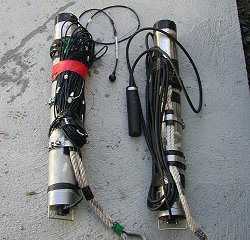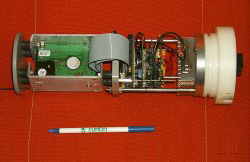Underwater sound recorder

Two Underwater Sound Recorders ready for deployment
The CMST Underwater Sound Recorder (USR) is an innovative device capable of autonomously collecting large amounts of acoustic data under a range of sampling schemes. The USR can be deployed for up to two years and is particularly suited to long term monitoring of man-made and natural underwater sound. It has been successfully used for studies of biological sea noise (fish, whales, etc.), physical sea noise (breaking waves), and a variety of man-made underwater sounds.

Underwater Sound Recorder Internals
Specifications
- Integral Pre-Amplifier (20dB gain, user selectable lower frequency cutoff filter – 8Hz or 160Hz).
- Integral Anti-Aliasing Filter (0-20db pre filter gain, 6th order Butterworth filter, high frequency cut off from 1kHz to 15kHz, additionally 0-20dB of post filter gain is available on a secondary output).
- 16 bit Analog to Digital Conversion (RMS noise of A/D – 3 quantisation levels) (Note: total recorded noise level depends on hydrophone capacitance, pre-amplifier used, amplifier gain, cut-off frequency, etc).
- Power Supply, GPS and Terminal Interface Card.
- IDE Hard disk drive interface card.
- Processor card with onboard sea noise recorder firmware and Compact Flash interface; User configurable via RS232 interface (sampling rate (up to 26k samples/sec), bandwidth, gain, sampling durations, record intervals) (support for two user configured sampling schedules).

Blue whale calls off Rottnest – January 2002
- Data Storage – one 2.5″ hard disk drives (size determined by availability, generally in the region of 60GB to 160GB) and Type 1 Compact Flash Card (256MB) (The hard drives use FAT32 file structure and can be read with a standard Windows PC – individual files for each recording event).
All electronics fixed to a mounting plate and are designed to suit a 100mm ID housing.
A range of analytical software is also available on negotiation. Specifications are subject to change and continuous improvement.
